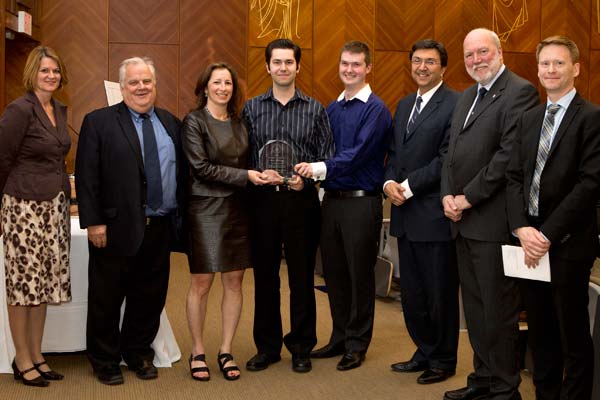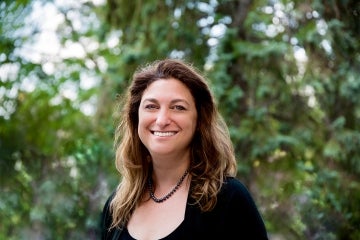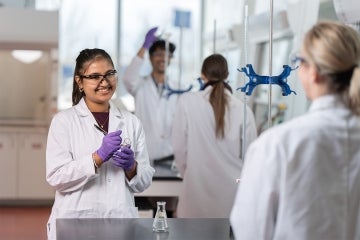
Meet U of T's Inventors of the Year
Published: May 16, 2013
Dietary advice tailored to your DNA and a “bio-printer” that prints skin-like tissue that can be used to dress wounds are two inventions that might change your life in coming years.
They’re also two of 10 inventions whose creators were celebrated May 15 at the University of Toronto’s 2013 Inventors of the Year ceremony.
“The Inventor of the Year Award is meant to recognize inventions that have the potential to improve our quality of life,” said Professor Paul Young, vice-president (research and innovation). “The winning inventions represent the very best of innovation at U of T, and on behalf of the University, I extend my congratulations.”
To qualify for the award, entrants and their teams must be faculty members or trainees who disclosed their inventions to U of T’s Innovations and Partnerships Office within the past five years. Inventions are assessed based on their uniqueness, potential for global impact and commercial appeal.
Many of the inventions include students as co-inventors.
“More than two-thirds of all inventions disclosed at the University of Toronto have a student or post-doc as a co-inventor, and this is also reflected in the winning projects," said Young. "We have several entrepreneurship education initiatives on campus, but in many ways, the best experience is practical.
"Students at U of T have the opportunity to work with some of the world’s leading inventors, and they’ll take that creative spirit with them wherever they go after graduation.”

The 2013 Inventors of the Year are:
■Ahmed El-Sohemy (Department of Nutritional Sciences). El-Sohemy has invented a panel of seven genetic markers that can be used to determine a person’s response to seven key components of diet: vitamin C, folate, whole grains, omega-3 fat, saturated fat, sodium and caffeine, leading to personalized DNA-based dietary recommendations.
■Axel Guenther (Department of Mechanical and Industrial Engineering and Institute for Biomaterials and Biomedical Engineering–or IBBME) with Milica Radisic (IBBME), Lian Leng, Arianna McAllister, Andrew Woollard and Boyang Zhang. Guenther’s team has developed a 3D “bio-printer” that can produce wound dressings that accurately mimic human skin.
■Patrick Gunning (Department of Chemical and Physical Sciences, UTM). Gunning has invented a drug-like molecule that targets STAT 3, a protein involved in many human cancers.
■Steve Joordens (Department of Psychology, UTSC) with Dwayne Pare. Joordens and Pare created peerScholar, a cloud-based eLearning tool that supports the development of critical thought.
■Peter Lehn (The Edward S. Rogers Sr. Department of Electrical and Computer Engineering–or ECE). Lehn has invented a new power electronic circuit topology for ultra high efficiency power conversion from low voltage to high voltage dc.
■Andreas Mandelis (Department of Mechanical and Industrial Engineering, IBBME and ECE) with Jose A. Garcia, Jinseok Jeon, Anna Matvienko and Lena Nicolaides. The team of inventors, which includes Dr. Stephen Abrams, CEO of Quantum Dental Technologies, has invented a way to monitor cavities without using ionizing dental x-rays.
■Milos Popovic (IBBME), Santa Huerta Olivares, Massimo Tarulli, Peter Lehn (ECE) and Aleksandar Prodic (ECE and Computer Engineering). The team is designing neuroprosthetic devices that help restore or replace nervous system function damaged by stroke or spinal cord injury.
■Molly Shoichet (Department of Chemical Engineering & Applied Chemistry and IBBME) with Dimpy Gupta, Charles Tator (University Health Network), Jordan Wosnick and Ryan Wylie. Shoichet’s team develops materials for drug delivery and regeneration.
■Gilbert Walker (Department of Chemistry) with Nikhil Gunari. Walker and Gunari are focused on keeping ship hulls free of fouling organisms and keeping aquaculture nets clean. They have invented a marine biofouling solution that keeps aquaculture nets clean, reducing the cost of fish farming.
■Daniel Wigdor (Department of Computer Science and Department of Mathematical and Computational Sciences, UTM) with co-inventor Ricardo Jota. Wigdor and Jota are investigating the lag between a user’s input to a smartphone or tablet and the system’s response, and developing technology to reduce this lag.
Read more information on the winning projects and inventors.
Jenny Hall is a writer with the Office of the Vice-President, Research and Innovation.


